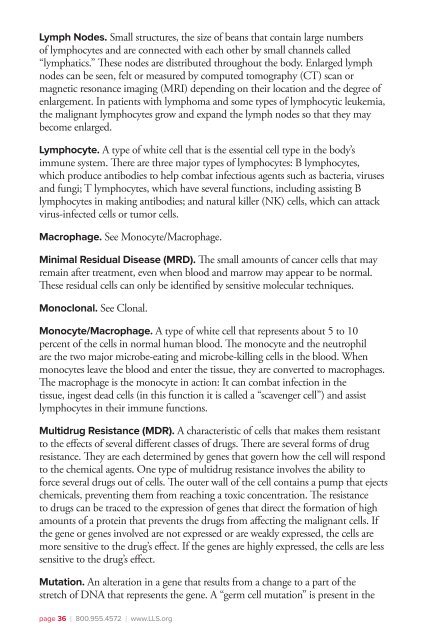Chronic Lymphocytic Leukemia - The Leukemia & Lymphoma Society
Chronic Lymphocytic Leukemia - The Leukemia & Lymphoma Society
Chronic Lymphocytic Leukemia - The Leukemia & Lymphoma Society
Create successful ePaper yourself
Turn your PDF publications into a flip-book with our unique Google optimized e-Paper software.
Lymph Nodes. Small structures, the size of beans that contain large numbers<br />
of lymphocytes and are connected with each other by small channels called<br />
“lymphatics.” <strong>The</strong>se nodes are distributed throughout the body. Enlarged lymph<br />
nodes can be seen, felt or measured by computed tomography (CT) scan or<br />
magnetic resonance imaging (MRI) depending on their location and the degree of<br />
enlargement. In patients with lymphoma and some types of lymphocytic leukemia,<br />
the malignant lymphocytes grow and expand the lymph nodes so that they may<br />
become enlarged.<br />
Lymphocyte. A type of white cell that is the essential cell type in the body’s<br />
immune system. <strong>The</strong>re are three major types of lymphocytes: B lymphocytes,<br />
which produce antibodies to help combat infectious agents such as bacteria, viruses<br />
and fungi; T lymphocytes, which have several functions, including assisting B<br />
lymphocytes in making antibodies; and natural killer (NK) cells, which can attack<br />
virus-infected cells or tumor cells.<br />
Macrophage. See Monocyte/Macrophage.<br />
Minimal Residual Disease (MRD). <strong>The</strong> small amounts of cancer cells that may<br />
remain after treatment, even when blood and marrow may appear to be normal.<br />
<strong>The</strong>se residual cells can only be identified by sensitive molecular techniques.<br />
Monoclonal. See Clonal.<br />
Monocyte/Macrophage. A type of white cell that represents about 5 to 10<br />
percent of the cells in normal human blood. <strong>The</strong> monocyte and the neutrophil<br />
are the two major microbe-eating and microbe-killing cells in the blood. When<br />
monocytes leave the blood and enter the tissue, they are converted to macrophages.<br />
<strong>The</strong> macrophage is the monocyte in action: It can combat infection in the<br />
tissue, ingest dead cells (in this function it is called a “scavenger cell”) and assist<br />
lymphocytes in their immune functions.<br />
Multidrug Resistance (MDR). A characteristic of cells that makes them resistant<br />
to the effects of several different classes of drugs. <strong>The</strong>re are several forms of drug<br />
resistance. <strong>The</strong>y are each determined by genes that govern how the cell will respond<br />
to the chemical agents. One type of multidrug resistance involves the ability to<br />
force several drugs out of cells. <strong>The</strong> outer wall of the cell contains a pump that ejects<br />
chemicals, preventing them from reaching a toxic concentration. <strong>The</strong> resistance<br />
to drugs can be traced to the expression of genes that direct the formation of high<br />
amounts of a protein that prevents the drugs from affecting the malignant cells. If<br />
the gene or genes involved are not expressed or are weakly expressed, the cells are<br />
more sensitive to the drug’s effect. If the genes are highly expressed, the cells are less<br />
sensitive to the drug’s effect.<br />
Mutation. An alteration in a gene that results from a change to a part of the<br />
stretch of DNA that represents the gene. A “germ cell mutation” is present in the<br />
page 36 I 800.955.4572 I www.LLS.org

















